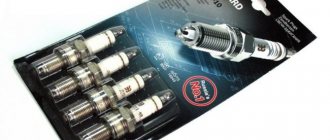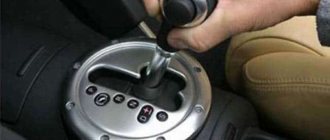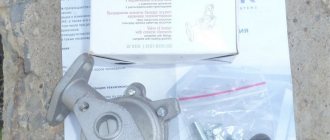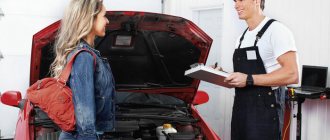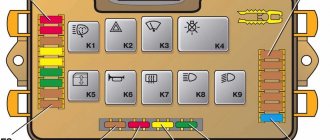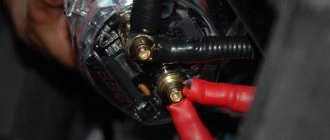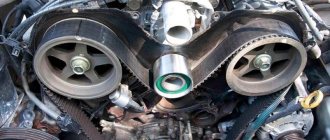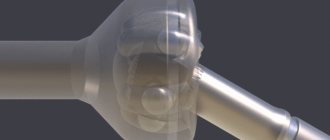What is a car boot?
Interconnected parts of the car require constant protection.
The presence of various lubricants in the units (interaction points) requires the use of covers that prevent the leakage of lubricant, as well as the ingress of various microparticles (dust, water, dirt, etc.). These protective special covers are made of rubber and are called anthers. They can be of completely different sizes and shapes, for example, elongated or bell-shaped, but they all have only one purpose - to protect any rubbing joint (hinge or any other). Any damage to the boot is a fairly serious nuisance, because even the smallest crack will lead to moisture and dust getting into it. This creates an abrasive that can lead to faster wear, corrosion, and operational problems.
Since the anthers are subject to various influences, it is necessary to constantly check their condition. This is necessary so that you can replace them with new ones in time, thereby preventing disruptions in the operation of the unit protected by the anthers.
For the boot to do its job perfectly, it must have the following characteristics:
- The material used for manufacturing must be elastic;
- The boot must be adapted to function under a wide variety of temperature conditions and be resistant to aggressive environments;
- There should be no reaction to fuels and lubricants.
Caring for anthers: features of repair and replacement
Drivers need to regularly check the boots and monitor their working condition. Even a small crack on anthers for a car indicates that they urgently need to be replaced. After all, even through a small hole, dust penetrates, which harms the general condition of the suspension.
The role of anthers in a car is the preservation and longevity of suspension parts, so you should not allow them to wear out.
If you notice a violation in the tightness of the anthers, it is better to replace them, although some car enthusiasts are trying to restore the working condition of the auto part. In some cases, the boot can indeed be restored, but most often the priority is replacement.
The most difficult thing is to replace the boot that protects the shock absorber - you have to completely disassemble the strut. You can see how to replace the CV joint without removing the CV joint boot in the attached video instructions.
Image from yandex.ru
If you study the complexity of the damage, you can get by with restoring the boot instead of completely replacing it. In general, it all depends on the situation. When a shock absorber just begins to fail, lubricant leaks into it (in most cases), and the seal of the element is broken. At the same time, the car boot moves, and the shock absorber piston becomes open to external stimuli.
If the boot remains intact, you can try to correct the situation by attaching it with a bandage. Leaving the boot leaking can cause shock absorber failure.
Anther wear is monitored when changing tires before the new season. They are also checked during a technical inspection of the car or when strange sounds are heard, similar to creaking or there is a knock heard from the car’s chassis.
CV boot
CV joint is a part of every car with front-wheel drive. Its design provides for 2 “grenades” (the second name for CV joints) on each side (one internal and the other external), each of them is protected by an external CV joint boot and an internal CV joint boot, respectively. They are usually made of silicone or neoprene to provide protection even under the most difficult conditions.
In appearance, the CV joint boots resemble a cone, which is folded like an accordion. This shape was chosen for a reason - thanks to it, the part can be protected from pinching when the angle changes. The boot is fixed on both sides with clamps, which help to reliably protect the hinge from dust.
If the drive is regularly inspected, any damage to the boot can be noticed in time. If you find the slightest crack or other defect that could break the seal, you must immediately replace the boot with a new one.
Replacing the boot is not such a difficult task, but it is quite troublesome. The first step is to dismantle the drive. Next, after completing this process, the damaged boot is cut and then the grenade is removed. Before putting a new boot on the hinge, you need to wash it and then apply lubricant. If everything is done, you can return the parts back to their place.
Clamps, as well as a damaged boot, must be replaced and cannot be reused. You can find out more about replacing the CV joint boot in the article “Replacing the outer CV joint and CV boot.”
What are anthers and why change them?
Many inexperienced car owners often encounter, after undergoing diagnostics, a recommendation from the technicians: “you need to change the boot.” Not everyone understands how terrible this situation is and how to solve this problem. In fact, replacing the boot is a completely normal situation that all drivers face sooner or later. It all depends on how quickly the problem is corrected, because untimely replacement of a torn boot can lead to more serious situations in the future.
Let's consider what is the point of using such a part as “anthers”, why they need to be changed and what will happen if this is not done.
Boot as an important element of the car
Judging by the name, it is clear that this auto part is related to dust. Anthers are protective covers for various car components that are contraindicated for contact with dust or a water-mud mixture. Anthers have different shapes - ring-shaped - protect the car assembly from lubricant leaks, bell-shaped - used in ball assemblies, on the “grenade” of the CV joint , with an elongated shape, like a trunk with wrinkles, - on steering racks . Each of these types of anthers is created for one purpose - to protect the assembly from the penetration of foreign objects and dirt.
What happens if the boot is not in place?
Not everyone understands why automotive components need protection. If we take ball joints, then this is, in principle, a simple mechanism that effectively fulfills its role where it is necessary to ensure the movement of any elements along several planes. The ball joint allows parts that are rigidly coupled to each other to nevertheless be movable in relation to each other. This is a fundamental difference from bolted connections. A ball joint is an important component of any car, which takes on increased loads when driving, and if it fails, then at the same moment the entire assembly is destroyed. For example, if the lower ball joint is damaged, the steering will be blocked, and if it is also torn out of its mounting, the wheel will fall to one side, which can damage the fender and doors of the car. This is a very dangerous situation and you will be lucky if no one gets hurt. Car breakdowns can be perceived as a normal situation. Fortunately, the design features of the ball are such that it breaks at low speed when starting to move. But, of course, theoretically it can be torn out at high speeds if the wheel lands in a hole or on a bump.
Price list for spare parts from 09/28/2021
Watch on the website Online
What causes ball wear?
In the vast majority of incidents, sudden failure of a benign ball joint is the result of torn anthers. A small piece of rubber, similar to a bell, which, after installation, is compressed into a thin strip and is almost invisible, plays an important role for the stable operation of the ball, and is the key to the long service life of the entire vehicle assembly and confident, safe driving.
Steering rack boots
Externally, these parts do not resemble a ball boot, but functionally they are similar, that is, they also provide protection for the steering rod from the penetration of dirt and moisture, and retain lubrication inside the mechanism. The problem here may be similar - small ruptures and cracks in the boots gradually displace the lubricant from the assembly and clog everything with dirt impurities. As a result, this will lead to complete steering functionality. We do not recommend delaying the replacement of the boot to avoid more serious consequences.
CV boot
The CV joint or “grenade” of the drive, as this element is called because of its similarity to a weapon, also needs protection from dust. Structurally, the CV joint is more complex than a ball or steering rack, and it is also more demanding and capricious in operation. The abbreviation “CV joint” means “constant velocity joint”. This element provides a front-wheel drive car with the same trajectory torque when cornering, and at the same time they are the leading pair in the car. Unlike rear-wheel drive cars, whose rear wheels only push the car forward, in a front-wheel drive car the front wheels both pull the car and provide its maneuverability when cornering. It is the CV joint that ensures this procedure. In the CV joint system, great importance is attached to the “grenade”, which consists of a complex ball joint and can rotate along different planes. The boot worn on the grenade plays a very important role here. When the boot loses its tightness, dirt gets into the grenade, which washes out the lubricant from it, as a result of which when turning you can hear a crunching sound that becomes louder and more disgusting every day. If the CV joint is “crunchy”, then only replacement will help; this part cannot be repaired. Of course, you can drive with the crunchy drive for some time until the driver gets tired of it or until it completely jams, which is very dangerous. Grenades are quite expensive items, especially original ones, but there is practically no choice. Of course, you can supply a non-original duplicate, which will not last long, or use a contract part - which will be like a lottery. It all depends on the car owner.
The safest and best option is to periodically check the condition of the anthers in order to prevent problems in time. If the boot is leaky, it needs to be replaced. Note that replacing the CV boot is also not the cheapest operation, because in any case you will need to remove the entire assembly. The price of even the original boot is quite inexpensive; the main costs will go to the work of the master. If you don’t change the boots and drive with a crunch, the consequences will be tragic - the unit can completely jam and block the wheels while driving. The car will become uncontrollable, the second end of the drive may break out of the gearbox, damaging its housing. In the end, everything can cost much more than simply replacing the CV joint boot. It's easier to not allow this to happen.
What can happen when the anthers rupture
When the boot ruptures, dust, dirt, and water immediately begin to enter the space of the vehicle assembly, depending on the road situation. When the mud mass increases, it penetrates deep into the mechanism and, like an abrasive grater, begins to corrode the surface of the parts. First, the microgaps increase, water will cause rusting, and then all the mud substance in a short time simply destroys the entire assembly. This negative process cannot be stopped; at best, you will have to completely disassemble the assembly and change the boot. The ball joint can still be saved, but when it comes to the CV joint, then, as they say, its song is done.
Note that difficulties also lie in the impossibility of determining in advance whether the stage of node destruction has already begun or not. The mechanic at the service station, seeing the damage to the boots, will say that they urgently need to be replaced before they break completely. But it is not possible to really determine when defects appeared in the boot. Maybe just now, or maybe a long time ago. There is only one way to solve the problem - check the part for play and change the boot. If there is no play, you are lucky. But if there is even a slight deviation, then the spare part needs to be replaced, repaired, and a new boot installed.
Get regular maintenance !
Our contacts
st. Gvardeiskaya, 53, building 2
Sign up for repairs
Tie rod boot
Anthers are also used in the steering. Their shape, as well as their fastening, are determined by the specific design. The difficulty of replacing the boot directly depends on where they are attached:
- If the boot is located in the place where the steering rods are attached to the rack, as, for example, in the “nine”, then you will have quite a difficult time, since to replace it you need to perform a number of procedures, which include disassembling the steering mechanism.
- In VAZ cars, the anthers are usually located at the ends of the rack. To replace any of them, you will only need to remove the clamps, then unscrew the nut that secures the rod, disconnect it and remove the boot.
- Among the many types of anthers you can find some very interesting ones. For example, in one of the Volkswagen models they are made in the form of elastic caps, which are put on the body and secured with clamps. Such boots protect the steering mechanism from dirt and are quite easy to change.
Diagnostics
The only method for diagnosing the condition of the CV joint boots and steering rack is inspection. If there are non-through cracks on the surface of the boot, it is necessary to replace it with a new one. If there are holes in the boot, fragmentation of the boot, or when the boot comes off its seat, in most cases it is necessary to change the CV joint, since even short-term exposure to dirt and water causes its damage and failure. The above is also true for steering rack boots. If a worn steering rack boot is not replaced in a timely manner, the steering rod, and in some cases the steering rack, also breaks down and fails.
Figure 1. Shows a torn CV boot. In such a situation, the CV joint will most likely need to be replaced.
Ball joint boot
This type of anther differs from the models described above in that their design resembles a mushroom, where the narrow part fits tightly to the finger, and the wider part is located on the body of the support itself. A retaining ring is used to secure the boot.
Replacing a damaged ball joint boot is quite easy. You just need to disconnect the hub and support, and then carefully pry up the retaining ring with a screwdriver. After you have done this, you can safely remove the boot from the support. Before installing a new boot, it is necessary to wash all surfaces as thoroughly as possible and also lubricate them.
The same boots are used for tie rod ends - they are absolutely identical (both the design itself and the method of replacement). Size is the only thing that makes them different.
Examples of CV joints.
Fig 4. Original repair kit for the outer CV joint boot for a Toyota car. In addition to the outer boot itself, the kit includes an inner boot, two sets of clamps, two retaining rings and two types of lubricant.
Fig. 5. Duplicate repair kit for the outer CV joint boot from Blue Print. The kit includes a boot, a set of clamps and lubricant.
Fig. 6. Duplicate repair kit for the outer CV joint boot from Maruichi. The kit includes a boot and a set of clamps.
Fig 7. Duplicate repair kit for the outer CV joint boot from Forsazh. The kit includes a boot and a set of clamps. Example of import substitution:
Shock absorber boot
These boots are used to protect shock absorbers; they are usually made in the form of a corrugated rubber cover and quite often are not secured at all. They are held in place due to a good fit, and their purpose is to protect the rod from dust and dirt. As always, there are exceptions - the VAZ “classic”, where a metal cover is used. It, of course, provides longer-lasting protection, but is less effective than its relatives made of rubber.
Thanks for subscribing!
The requirements for the material from which the anthers are made are very high, because in order to function as needed under overload conditions, it must withstand a fairly wide temperature range. In addition, it must be durable and not be destroyed when it gets exposed to oil or salt, which is used to treat roads in winter.
Stabilizer links
Anthers also perform a similar protective function on other components, for example, on stabilizer links or on steering tips. Small anthers cover, one might say, a smaller copy of the same ball joint. However, there are also some nuances here. If the anthers on the steering tips can be changed, then on the links it is not technically possible to replace this protective part, and therefore you have to change the entire part. But, I would like to note that failure of the stabilizer link boot occurs extremely rarely, usually due to old age, and even less often due to poor quality of the unit itself.
A stabilizer link failure is not as bad as a ball joint failure. When it fails, the car’s suspension begins to produce extraneous sounds on almost every unevenness in the road surface. Even the slightest play will cause the appearance of extraneous sound, which, in resonance with other suspension parts, will lead to natural rumble. But if you are not sensitive to such noise, then we can make you happy, the faulty link will quite last for a standard replacement. Even if suddenly the link does not reach the service station and falls off, nothing critical will happen, at most, the stabilizer will fall off and scrape along the asphalt while driving.
This is unlikely to harm the stabilizer itself; during repairs, it will only be returned to its place and will not be changed. True, from the outside, such a breakdown of a car will look quite scary, but still there is no need to worry too much; according to statistics, such breakdowns do not cause much harm to the car and the driver and passengers. Well, it’s a completely different matter, the failure of the tie rod end, which at first will signal the driver with extraneous noise when driving, and in the event of a final breakdown, can even lead to a complete loss of control of the car. Therefore, we advise that if you discover a broken tip, you should immediately contact a service station so that the boot can be replaced .
Brake caliper boot
There are two types of caliper boots - one of them is intended for the guide, and the second protects the piston. They differ in shape, but both are made of a springy material that can withstand overloads and protect the caliper from dust.
Quite often, a car boot is changed during scheduled repairs. If you find any damage, it is best to immediately replace the worn part with a new one. A replacement that is not carried out on time can very well lead to very sad consequences.
The selection of CV joint boots and steering rack boots is carried out in several ways:
1. Using automaker catalog programs. In most original programs, anthers are not presented as independent parts, but are supplied as repair kits. In addition to the boot itself, the repair kit includes lubricant, retaining rings, and clamps. Often, the repair kit for the outer boot also includes an inner boot. Such an abundance of additional elements significantly increases the cost of the part. On some modern cars, the manufacturer does not supply boots even in the form of repair kits, but offers to purchase the drive assembly. The use of original CV joint boot repair kits allows you to achieve maximum quality when repairing a car. The negative side is the relatively high cost of original CV joint boot repair kits. Fig 2. Shows a repair kit for CV joint boots for a MAZDA car. The illustration shows that the repair kit for the outer CV joint boot, in addition to the boot itself, includes a retaining ring, two sets of clamps and two types of lubricant for the outer and inner boots:
2. Using catalogs of duplicate manufacturers. Some duplicate manufacturers supply only boots, others complete boots with sets of clamps, and still others offer entire repair kits. A positive aspect when using duplicate CV joint boots is the relatively low cost of these boots. The negative aspect is the shorter service life of duplicate CV joint boots relative to the original boots. There is also a lack of lubricant in most duplicate boots, which will have to be purchased additionally; also, during the assembly process of the drive, a retaining ring for the CV joint may be required, which is also missing in most duplicate CV boots.
3. The method consists of selecting CV joint boots or steering rack according to the sample. This method is used in several cases: - the buyer managed to dismantle the boot before going to the store and brought it with him. — the buyer does not have the opportunity to purchase an original boot and needs to select a duplicate boot, however, the seller does not have unambiguous information in the duplicate catalogs available to him as to which boot will fit this car. — the car was previously equipped with a contract drive and those boots that are recommended in the catalogs do not fit it.
Flywheel boot
This boot especially stands out among the rest. Metal is used to make it - this is its main difference from other variations. The flywheel boot is designed to reliably protect the part itself from the ingress of third-party liquids or particles, which is why it has a second name - the clutch housing cover.
Of course, just like other parts, it can be mechanically damaged or worn out. If it is not possible to restore its working condition, then it must be replaced.
